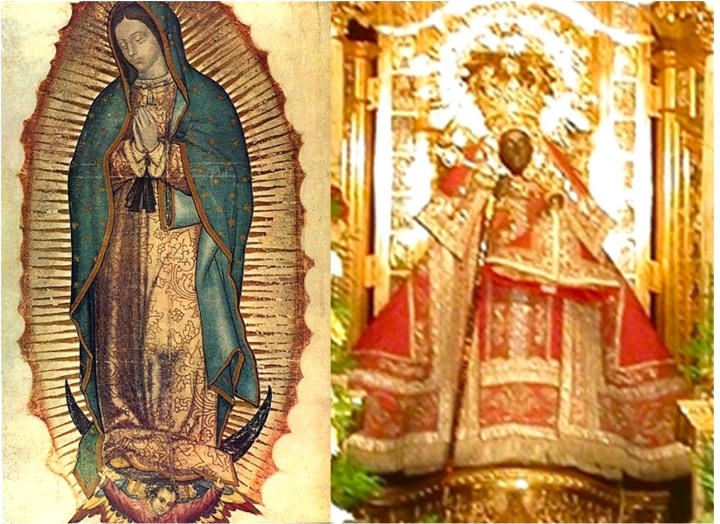
Photo above: Left: Our Lady of Guadalupe image on the tilma, Mexico City, Mexico. Right: Statue of Our Lady of Guadalupe in Extremadura, Spain. Both images are public domain, found in Wikimedia Commons.
December 12 is observed as the Feast of Our Lady of Guadalupe in the Catholic calendar. Some points about the apparitions of this Virgin:
- Soon after 1521, with the completion of the Spanish conquest in Mexico, a systematic destruction of pre-Hispanic buildings and polytheistic temples had been implemented, in order to completely eliminate native traditions and religion; this included the demolition of the site dedicated to a goddess, referred to as Tonantzin (meaning “Our Lady, Our Mother”) on the hills of Tepeyac. This is exactly the same site of the Virgin of Guadalupe apparitions between December 9 and 12, 1531, to Juan Diego, a humble native man who converted to Catholicism.
- Tonantzin had been celebrated by the natives each year, around the day of the winter solstice which, strangely enough, occurred on December 12 back in the year 1531.
- An image of the lady appeared on Juan Diego’s tilma (native men’s robe); she was dark skinned and had mestizo (mixed Spanish and native) features (photo at the top of this post, left.)
- It is said that the lady asked to be named Guadalupe, but the apparitions were not documented for decades, and only after Juan Diego’s death. By some, the name “Guadalupe” is believed to derive from a goddess name in Nahuatl, Coatlaxopeuh, while the more general consensus is that the name came directly from the Lady of Guadalupe in Extremadura, Spain.
- A banner of the Lady of Guadalupe was adopted by the insurgent army during the Mexican war of Independence.
Our Lady of Guadalupe in Extremadura was the patron of Extremadura , and in 1928, was also awarded the title of “Queen of all Spain” or “de La Hispanidad.” Some points about the apparitions of this Virgin:
- When the Spanish city of Seville was taken by the Moors in 712, a statue of the Madonna (Virgin Mary and Child Jesus) was hidden by burying it somewhere in the hills, near the Guadalupe River in Extremadura. Hundreds of years later, at the beginning of the 1500s, the Virgin Mary appeared to a humble farmer named Gil Cordero who was searching for a missing cow. Cordero said that the Virgin had asked him to tell the clergy to dig at the place of her apparition. The priests found the hidden statue, and built a small shrine, later becoming a monastery. The statue was vested in gold robes, surrounded by gilt columns, and remains in Extremadura (photo at the top of this post, right.)
- This Madonna also has dark skin.
- It was at that monastery that queen Isabelle I and king Ferdinand II signed the authorization of the first voyage of Christopher Columbus to the Americas, who reached the New World on October 12, 1492. The statue was canonically crowned on October 12, 1928, by Pope Pius XI.
- Hernán Cortez and other Spanish conquerors, embraced this virgin as their patroness during the conquest of the Mexica (Aztec) Empire.
Two Ladies of Guadalupe, both dark skinned, related to apparitions to humble men, and with origins that inspire patriotism and devotion. Sceptics could argue that these were not facts, but just a comedy of church schemes to exalt the resurgence of Catholicism in the Iberian Peninsula after the conclusion of the Moor occupation, and to ease the conversion process in the American continent after the Spanish conquest. Some might think the points above are just coincidences, while others truly believe they are affirmations of the miracles of each Lady of Guadalupe.








I never knew about the Lady of Guadalupe/Spain. In religion classes, we were only told about Juan Diego and the Mexican Lady.
LikeLike
Same here, I just learned about the Extremadura one a few years ago.
LikeLiked by 1 person
It’s a miracle. The comedy lies in the naming of Our Lady of Coatlaxapeuh. I think the Spaniards pronounced it wrong and Guadalupe. I visited her in my younger days and next year my siblings will pay homage to her. Happy feast of Our Lady of Guadalupe 🙏
LikeLike
Wonderful, have a very happy día de la virgencita!
LikeLike
This might interest you…
LikeLike
Thank you, Perpetua, I’ll take a look.
LikeLike
What a great piece of history. I love the Aztec, Mexicano languages. They just sound mystical when you learn to pronounce them, don’t they?
LikeLiked by 1 person
Indeed, thank you, Mason!
LikeLiked by 1 person